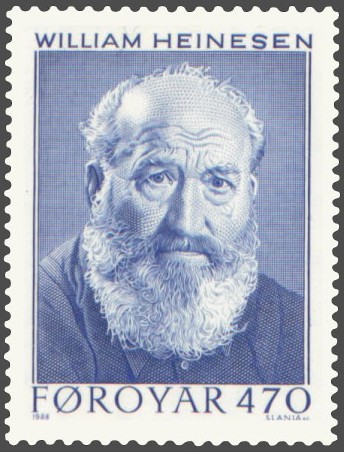- William Heinesen
Infobox Person
name = William Heinesen

caption =
birth_date =15 January ,1900
birth_place =Tórshavn
death_date = death date and age|1991|3|12|1900|1|15
death_place =Tórshavn Andreas William Heinesen (
15 January 1900 -12 March 1991 ) is the most famous writer from theFaroe Islands . He was also a poet, a composer and a painter.His Writing
The Faroese capital Tórshavn is always the centre of Heinesen's writing. He is famous for having once called Tórshavn "the navel of the World". His writing focuses on contrasts between darkness and light, between destruction and creativity. Then following is the existential struggle of man to take sides. This is not always easy, however, and the lines between good and bad are not always clearly defined. Furthermore, Heinesen was captivated by the mysterious part of life. He called himself religious in the broadest sense of the word. His life could be described as a struggle against defeatism. One oft-quoted aphorism of his is that "life is not despair, and death shall not rule".
Publications
As he was born and raised before the Faroese language was taught in the schools and his mothertongue was Danish.
He published his first collection of poetry when he was 21. He had three more published before he wrote his first novel "Blæsende gry" - Stormy Dawn - in 1934. He read every single one of the chapters to the painter
Sámal Joensen-Mikines , as he was worried that his Danish wasn't good enough. That was followed up with "Noatún" (1938). Noatún has a strong political message - solidarity is the key to a good society. His next book "The Black Cauldron" (1949) deals with the aftermath of decadent living combined with religious hysteria. In "The Lost Musicians" (1950) Heinesen leaves the social realism of his earlier works behind, instead giving himself over to straightforward storytelling. "Mother Pleiades" (1952) is an ode to his imagination. Its subtitle is "a Story From the Beginning of Time".Heinesen wasn't content with writing only novels. In the fifties he began writing short stories as well. Most of them have been printed in these three collections entitled "The Enchanted light", "Gamaliel's Bewitchment" and "Cure Against Evil Spirits" (1969). In the novel "The Good Hope", his main character the Rev. Peder Børresen is based on the historical person Rev.
Lucas Debes . When Heinesen was asked how long it had taken to write it, he answered "forty years. But then I did other things in between"Recognition
He received
The Nordic Council's Literature Prize in 1964 for his novel "Det gode håb" ("The Good Hope"). In the story Heinesen had the difficult task of reproducing 17th-century Danish. He succeeded, and won the prize. It is widely considered his best work.When there were rumours that William Heinesen was about to receive the
Nobel Prize for literature in 1981, he wrote to theSwedish Academy and renounced his candidacy. Later he explained why::"The
Faroese language was once held in little regard – indeed it was suppressed outright. In spite of this the Faroese language has created a great literature, and it would have been reasonable to give the Nobel Prize to an author who writes in Faroese. If it had been given to me, it would have gone to an author who writes in Danish, and in consequence Faroese efforts to create an independent culture would have been dealt a blow."Heinesen died in 1991 at the age of 91.
Bibliography
Information in this bibliography is taken from the Danish Literature Centre.cite web|url=http://www.litteraturnet.dk/danvalg/frameit.asp?dest=http://www.litteraturnet.dk/danvalg/f_portraet.asp!fid=83&fid=83|title=Bibliography (William Heinesen)|work=Literaturenet|accessdate=2006-07-09]
Poems
* Arktiske Elegier og andre Digte (Arctic Elegies and other Poems), Copenhagen 1921
* Høbjergningen ved Havet (Haymaking by the Sea), Copenhagen 1924
* Sange mod Vaardybet (Songs towards the Depths of Spring), Copenhagen 1927
* Stjernerne vaagner (The Stars Awaken), Copenhagen 1930
* Den dunkle Sol (The Dark Sun), Copenhagen 1936
* Digte i udvalg (Selected Poems), Copenhagen 1955
* Hymne og harmsang (Hymns and Songs of Indignation), Copenhagen 1961
* Panorama med regnbue (Panorama with Rainbow), Copenhagen 1972
* Vinterdrøm. Digte i udvalg 1920-30 (Winter Dream. Selected Poems 1920-30), Copenhagen 1983
* Samlede digte (Complete Poems), Copenhagen 1984
* Digte (Poems), Copenhagen 1990Short Stories anthologies
* Det fortryllede lys (The Enchanted Light), Copenhagen 1957
* Gamaliels besættelse (Gamaliel Possessed), Copenhagen 1960
* Kur mod onde ånder (A Cure for Evil Spirits), Copenhagen 1967
* Don Juan fra Tranhuset (Don Juan from the Whale Oil Factory), Copenhagen 1970
* Fortællinger fra Thorshavn (Tales from Tórshavn), Copenhagen 1973
* Grylen og andre noveller (The Gryla and Other Stories), Copenhagen 1978
* Her skal danses (Let There Be Dancing), Copenhagen 1980
* Laterna magica (Laterna Magica), Copenhagen 1985Novels
* Blæsende Gry (Windswept Dawn), Copenhagen 1934
* Noatun (Noatun), Copenhagen 1938
* Den sorte gryde (The Black Cauldron), Copenhagen 1949
* De fortabte spillemænd (The Lost Musicians), Copenhagen 1950
** The Lost Musicians. Sawtry: Dedalus, 2006 - ISBN 1 903517 50 8
* Moder Syvstjerne (The Kingdom of the Earth), Copenhagen 1952
* Det gode håb (The Good Hope), Copenhagen 1964
* Tårnet ved verdens ende (The Tower at the Edge of the World), Copenhagen 1976Heinesen's art on stamps
References
External links
* [http://www.dlb.dansklf.dk/iframe.dsp?author=243 Dansk Litteraturhistorisk Bibliografi]
* [http://www.abc-literature.dk/eng Website about William Heinesen with bibliography]
* [http://www.dedalusbooks.com/samples.php?id=00000183&s=1 Dedalus Books: The Lost Musicians, 2006]
Wikimedia Foundation. 2010.
